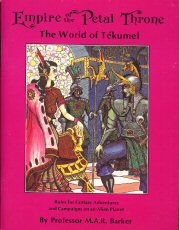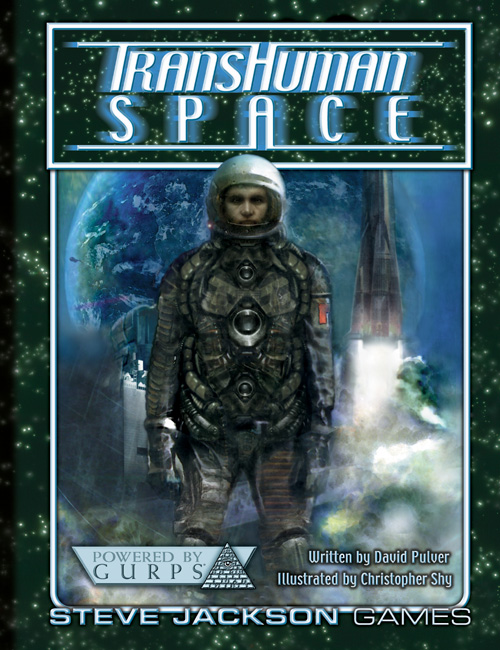"Land of Fear"
1st Issue Special #8 (November 1975)
Written and Illustrated by Mike Grell
Synopsis: Colonel Travis Morgan, USAF, is forced to ditch his plane after taking fire during a spy mission over the Soviet Union. Expecting to come down in the arctic, he's surprised to find himself in a lush jungle. Finding a woman, Tara, in combat with a dinosaur he rushes to her aid. No sooner have they overcome that danger, then they are captured by soldiers and taken to the city of Thera. Morgan quickly earns the enmity of the high priest, Deimos, though use of his pistol convinces the rest of the Theran court that he's a god. While guests of the Theran king, Morgan pieces together the remarkable truth of his situation--he's in the hollow earth! Ultimately, treachery by Deimos leads Morgan and Tara to flee Thera.
- The story begins on a specific date: June 16, 1969. Though time is strange in Skartaris, stories will often give reference to the passage of "real time" on earth--something very different from most comic series. This also dates Morgan, allowing us, as more information is given, to construct a timeline of his life.
- Morgan has a .38 special in this issue and only 12 rounds of ammo, all of which he uses here.
- The women of Thera seem go in for the colorful, raccoon-patch, eye shadow which is also styled by some female members of the disco-era Legion of Super-Heroes, Marionette of the Micronauts, and Dazzzler, among others.
The portrayal of the hollow earth in both fiction and purported fact has a rich history going back to Sir Edmund Haley (of comet fame) and possibly before. The primary inspiration for Grell’s version seems to be Pellucidar, a savage land debuting in At the Earth’s Core by Edgar Rice Burroughs, serialized (as “The Inner World”) over 4 issues in All-Story beginning on April 4, 1914. A novel version was published in 1922, and in 1976 there was a move adaptation with Doug McClure, Peter Cushing, and bond-girl-to-be Caroline Munro.
In the introduction to the collection Savage Empire (1991), Grell cites the Burroughs influence on Warlord and calls the Pellucidar series "the best of the [Earth's core] genre." In a later interview, he seems to downplay this influence, emphasizing instead Jules Vernes' Journey to the Center of the Earth, and The Smokey God by Willis George Emerson. Certainly a case could be made for the primacy of these works in Skartaris' conception. Verne's work has prehistoric survivors in his underground world, while Emerson's novel has a central sun (the titular Smokey God).
Still, Burroughs' work has those similarities to Skartaris, too. It also shares one feature not found in any other "hollow earth" fiction with which I'm aware: time is strange there. The odd timelessness of Skartaris is also found in Pellucidar--despite neither ever giving a good explanation as to why things should be that way.
An interesting parallel to Burroughs, though probably not a direct reference, is this issue's title. Burroughs' sixth novel of Pellucidar is called Land of Terror.
One thing clearly does come from Verne, and that's the name of The Warlord's hollow world. In Journey to the Center of the Earth, "Scartaris" is a mountain whose shadow marks the entrance to the center of the earth in the crater of Snæfellsjökull.
The dinosaur gracing the cover and appearing in the issue is identified as a deinonychus, which is a species related to the velociraptor family. Unlike its depiction in this issue, deinonychus apparently had feathers.
The character of Travis Morgan got his first name from Grell's nephew, and his surname from the privateer and rum bottle spokes-model, Henry Morgan. Morgan got the facial hair that Grell himself had at the time, and also Grell's experiences in the air force.
Grell has said that the appearance of Tara was inspired by Raquel Welch. Presumably he was thinking of her in One Million Years B.C. The name "Tara" was a popular one in the United States in the 70s, probably due to the enduring popularity of the film version of Gone With The Wind. In this context, the name Tara derives from the Hill of Tara in Ireland. The hill is also known as Teamhair na Rí (“The Hill of Kings”) because of its association with ancient kingship rituals. Tara also means "shining" in Sanskrit and is the name of a Hindu goddess.
Grell tells us he got "Deimos" from the name of Mars' smaller moon, the larger being Phobos. These names derive from Greek mythology where Deimos ("dread") and Phobos ("fear") are sons of Ares. Again, the title of the issue seems to have unintended connections.
The name of the city where Deimos is high priest, Thera, is also Greek in origin. Thera is part of what is now the Santorini Archipelago and the site of one of the largest volcanic eruptions in recorded history. This eruption, some 3600 years ago, led to the decline of Minoan civilization, and popular theory holds that this event may be the ultimate source of the Atlantis legend.





















